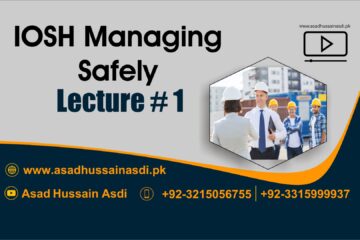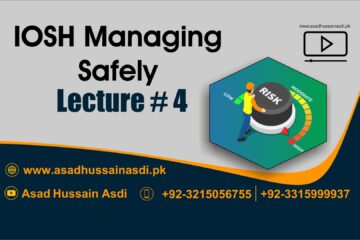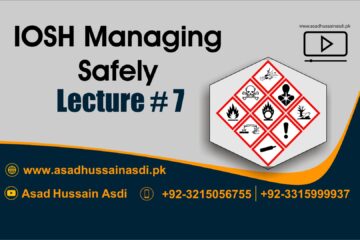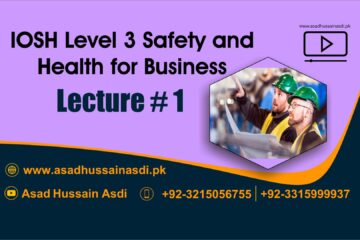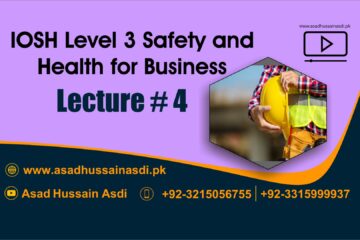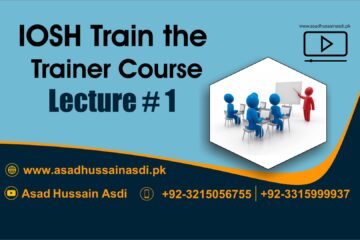ProQual Level 7 Diploma in Strategic Health & Safety Leadership and Management Course in Pakistan || Registration Open
Registration Open= +92-3315999937, +92- 3215056755 (WhatsApp Only)
Introduction
The Level 7 Diploma in Strategic Health & Safety Management and Leadership qualification is aimed at candidates who are responsible for developing and applying health and safety procedures day-to-day in any organisation. They are likely to be managers looking to improve their knowledge and skills.
The awarding body for this qualification is ProQual Awarding Body and the regulatory body is the Office of Qualifications and Examinations Regulation (Ofqual). This qualification has been accredited onto the Regulated Qualifications Framework (RQF).
Qualification Profile
Qualification title ProQual Level 7 Diploma in Strategic Health & Safety
Leadership and Management
Ofqual qualification number 603/6851/2 Level Level 7
Total qualification time 500 hours Guided learning hours 260
Pass or fail
Assessment
Internally assessed and verified by centre staff External quality assurance by ProQual verifiers
Qualification start date 1/12/2020 Qualification end date
Entry Requirements
There are no formal entry requirements for this qualification. Centres should carry out an initial assessment of candidate skills and knowledge to identify any gaps and help plan the assessment. This qualification is approved for candidates aged 19+
Qualification Structure
Candidates must complete all of the Mandatory units.
| Mandatory Units | |||
| Unit Reference
Number |
Unit Title | Unit
Level |
GLH |
| A/618/5596 | Risk-based safety systems management | 7 | 50 |
| F/618/5597 | Safety culture, sustainability and the global effect on
performance |
7 | 50 |
| J/618/5598 | Digital technologies and incident investigation | 7 | 50 |
| L/618/5599 | Development as a strategic manager | 5 | 50 |
| J/506/2048 | Establish business risk management processes | 5 | 50 |
Centre Requirements
Centres must be approved to offer this qualification. If your centre is not approved please complete and submit form ProQual Additional Qualification Approval Application.
Staff
Staff delivering this qualification must be appropriately qualified and/or occupationally competent. Requirements for Trainers, Assessors and IQA Verifiers are set out below:
Trainers must be appropriately qualified and occupationally competent in the areas in which they are training. They must have a minimum of 4 years’ experience in occupational health and safety for which they will be training and supervising. Trainers must hold:
i) a level 6 or Level 7 qualification in occupational health and safety
ii) a Level 3 Award in Education and Training or equivalent
iii) minimum membership level of IOSH at GradIOSH level
Assessors
For each competence-based unit centres must be able to provide at least one assessor who is suitably qualified and occupationally competent in the areas in which they are assessing. They must have a minimum of 5 years’ experience in occupational health and safety for which they will be assessing.
Assessors must hold:
i) an appropriate assessor qualification, such as:
· Level 3 Award in Assessing Competence in the Work Environment
· Level 3 Award in Assessing Vocationally Related Achievement
· Level 3 Certificate in Assessing Vocational Achievement
ii) a Level 6 or Level 7 qualification in occupational health and safety
iii) minimum membership level of IOSH at GradIOSH
Internal Quality Assurance
For each competence-based unit centres must be able to provide at least one IQA Verifier who is suitably qualified and occupationally competent in the areas in which they are internal quality assuring. They must have a minimum of 4 years’ experience in occupational health and safety for which they will be internal quality assuring and must demonstrate that they have undertaken Continued Professional Development (CPD) to maintain and update their skills and knowledge.
IQA Verifiers must hold, or be working towards:
i) an appropriate internal quality assurance verification qualification, such as:
· Level 4 Award in the Internal Quality Assurance of Assessment Processes and Practices
· Level 4 Certificate in Leading the Internal Quality Assurance of Assessment Processes and Practices
ii) minimum membership level of IOSH at CMIOSH
Support for Candidates
Materials produced by centres to support candidates should:
· enable them to track their achievements as they progress through the learning outcomes and assessment criteria;
· provide information on where ProQual’s policies and procedures can be viewed;
· provide a means of enabling Internal and External Quality Assurance staff to authenticate evidence
Assessment
This qualification is competence-based, candidates must demonstrate the level of
competence described in the units. Assessment is the process of measuring a candidate’s
skill, knowledge and understanding against the standards set in the qualification.
The qualification must be internally assessed by an appropriately experienced and qualified assessor.
Each candidate is required to produce a portfolio of evidence which demonstrates their achievement of all of the learning outcomes and assessment criteria for each unit.
Evidence can include: – observation report by assessor
– assignments/projects/reports
– professional discussion
– witness testimony
– candidate product
– worksheets
– record of oral and written questioning
– Recognition of Prior Learning
Learning outcomes set out what a candidate is expected to know, understand or be able to do.
Assessment criteria specify the standard a candidate must meet to show the learning outcome has been achieved.
Learning outcomes and assessment criteria for this qualification are set out from page 9.
Internal Quality Assurance
An internal quality assurance verifier confirms that assessment decisions made in centres are made by competent and qualified assessors, that they are the result of sound and fair assessment practice and that they are recorded accurately and appropriately.
Adjustments to Assessment
Adjustments to standard assessment arrangements are made on the individual needs of candidates. ProQual’s Reasonable Adjustments Policy and Special Consideration Policy sets out the steps to follow when implementing reasonable adjustments and special considerations and the service that ProQual provides for some of these arrangements.
Centres should contact ProQual for further information or queries about the contents of the policy.
Results Enquiries and Appeals
All enquiries relating to assessment or other decisions should be dealt with by centres, with
reference to ProQual’s Enquiries and Appeals Procedures.
Certification
Candidates who achieve the requirements for qualifications will be awarded:
· A certificate listing all units achieved, and
· A certificate giving the full qualification title –
ProQual Level 7 Diploma in Strategic Health & Safety Leadership Management
Claiming certificates
Centres may claim certificates for candidates who have been registered with ProQual and who have successfully achieved the requirements for a qualification. All certificates will be issued to the centre for successful candidates.
Unit certificates
If a candidate does not achieve all of the units required for a qualification, the centre may claim a unit certificate for the candidate which will list all of the units achieved.
Replacement certificates
If a replacement certificate is required a request must be made to ProQual in writing. Replacement certificates are labelled as such and are only provided when the claim has been authenticated. Refer to the Fee Schedule for details of charges for replacement certificates.
This unit aims to provide candidates with the knowledge of current ISO and other recognised standards – the implementation standard for occupational health and safety management systems. It will also evaluate the processes of risk management and risk communication.
- Be able to develop and implement current ISO standards for occupational health and safet
- Be able to evaluate strategic risks to an organisation through the implementation of a quantifiable risk assessment system
- Evaluate the extent to which the processes of an occupational health and safety management system links to any ISO clauses
- Analyse any gaps to be bridged to satisfy the requirements of an ISO occupational health and safety management system
- Evaluate the issues/challenges faced by an organisation while implementing an ISO compliant, or other recognised, occupational health and safety management system
- Evaluate the importance of understanding the organisation and its context whilst framing occupational health and management systems
- Analyse the external and internal issues have an impact on the way an organisation manages its occupational health and safety management system responsibilities
- Assess the way in which the activities of sub- contractors and third parties might have a negative impact on an organisation’s occupational health and safety systems
- Differentiate between the various recognised occupational health and safety standards
- Ensure the alignment of the occupational health and safety management system with an organisation’s strategic goals and that it meets legal, regulatory and compliance requirements.
- Evaluate the role of suitable leadership and management in the organisation risk reduction system(s)
- Analyse the value of accident causation in managing the impact of risk(s) identified
- Analyse the requirements of performing fault tree and event tree analysis to show fact based decisions
- Analyse the relevance, validity and value of different data sources and information to implement a quantified risk assessment model
- Evaluate the internal and external factors influencing the selection of different risk quantification models
- Be able to articulate risk communication strategies in various situations
- Develop practicable action plans that improve controls to reduce strategic risks and present them at director/board level
- Develop practicable strategies on the ways in which an organisation can assess hazards and risks following
changes in an organisation’s management, processes
and/or equipment
- Analyse the pitfalls in any risk transfer
- Analyse the different types and categories of strategic and dynamic risks
- Develop practicable strategies for risk communication for a range of situations that take stakeholders’ requirements and legal requirements into consideration
- Assign ownership and accountabilities and gain agreement from managers/directors and the workforce for strategic and dynamic risks
- Evaluate the importance of effective communication and consultation in a risk management process
- Analyse the way in which a crisis communication could differ from a risk communication
Assessment
There must be valid, authentic and sufficient for all the assessment criteria. However, one piece of evidence may be used to meet the requirements of more than one learning outcome or assessment criterion.
This unit aims to provide candidates with the knowledge of sustainability effects on safety culture, the psychological factors affecting safety, a whole-organisation approach to occupational health and safety and the measurement of safety performance.
- Be able to evaluate the effects of global 1.1 Evaluate the impact of globalisation on the safety
issues on safety culture
climate of an organisation
- Analyse the way in which perceptions of safety and unsafe behaviour vary between various countries
- Evaluate the role of management in ensuring the
development of a worker’s competence within their
role
- Develop practicable and operational plans for the effective management of occupational health and safety in a multi-employer worksite
- Analyse the way in which Globally Harmonised Systems could improve the communication of hazards and risk
- Evaluate the benefits of sustainability in 2.1 Develop a business case for the inclusion of
the workplace
- Be able to measure safety performance and calculate safety return on any investment
- Understand the effects of psychological health and injury management in the workplace
occupational health and safety in sustainability strategies
- Evaluate the challenges, opportunities and strategic business benefits in promoting sustainable workplace health and safety
- Specify the methods to be included that measure a sustainable occupational health and safety practice in workplaces
- Analyse the way in which error management can improve the safety performance in occupational health and safety management systems
- Develop a practicable model for calculating any returns on the occupational health and safety management system in operational and strategic terms
- Develop a data evidence method that measures the performance of the safety culture
- Evaluate the role of management in promoting good mental health within the workplace
- Analyse the challenges in dealing with mental health within the workplace
- Analyse the way in which the human rights of workers with mental health conditions should be protected in the workplace
- Analyse the factors and conditions contributing to possible workplace violence
- Analyse the early indicators of workplace confrontation
- Analyse the barriers to the implementation of a psychological health and safety management system in the workplace
- Analyse the ways in which an injury management
programme can have an impact on a worker’s morale
- Evaluate the potential costs of poor psychological and physical health and poor morale can have on an organisation
- Be able to lead the implementation of a 5.1 Evaluate the case for the integration of occupational
whole-organisation approach to occupational health and safety
health and safety into an organisation’s business
activity
- Develop a practicable whole-organisation approach to occupational health and safety in an organisation
- Analyse the relevance of a whole-organisation approach in tackling bullying and violence
- Scope the nature of interdependence in the components of an occupational health and safety system
- Develop a strategic response and operational plans that address aggregated, interdependent health and safety risks
Assessment
There must be valid, authentic and sufficient for all the assessment criteria. However, one piece of evidence may be used to meet the requirements of more than one learning outcome or assessment criterion.
This unit aims to provide candidates with the knowledge of digital technologies and risk assessment approaches to various types of hazards and incident investigation.
- Understand the effects of digital technologies on strategic and operational occupational health and safety management
- Evaluate the impact of digital technology on occupational health and safety within an organisation
- Analyse the ways in which advanced robotics and artificial intelligence could contribute to the improved reduction of risks
- Analyse the way in which advanced robotics and artificial intelligence could be detrimental to workers’ mental health longer term and develop a response that addresses these highlighted risks
- Be able to implement a biohazards risk 2.1 Analyse the way in which exposure and assessment
assessment and control measures in the workplace
- Understand the implementation of ecological risk assessment and control measures
- Be able to implement engineering solutions for ergonomic hazards and control measures
- Understand the requirements of the implementation of risk assessment for biological outbreaks and control measures
are used in risk management
- Analyse the way in which different workplaces can be protected from various identifiable infections
- Develop a strategy that can reduce/limit the spread of infection within different workplaces
- Analyse the requirements of a risk communication strategy to prevent the spread of infection
- Analyse the way in which the strategic and management goals of an organisation may be met whilst addressing the impact of industrial activities on an ecosystem
- Develop a realistic risk identification for an
organisation’s ecological activities
- Quantify an assessment for an organisation’s
industrial activities
- Evaluate the strategic and operational requirements of an ecological risk assessment that assesses the risks posed by industrial effluent on downstream ecosystems
- Analyse the ergonomic risk factors in the workplace and their strategic and operational implications
- Develop practicable ergonomic solutions that address risks in the workplace and their strategic and operational implications
- Quantify the costs and benefits of ergonomic solutions in the workplace
- Analyse the requirements of strategic risk and risk assessment for biological outbreaks
- Understand the likely failure scenarios for chemical hazards and control measures
- Be able to implement an accident causal analysis model for physical hazards
- Analyse the requirements of immediate, mid and long term effective control measures to be implemented
5,3 Analyse the factors to be considered for a post- disaster assessment and reviews
- Analyse the safety management requirements of process areas and identify likely failure points
- Analyse the suitability and sufficiency of control measures for a process area and develop plans for improvement
- Identify the case of an accident through the application of root cause analysis
- Develop practicable plans for the avoidance of similar accidents
- Assess the costs to an organisation of physical accidents (financial, loss of time, reputational damage, complaints and general worker welfare issues)
- Quantify the benefits of any enhanced safety control measures
Assessment
There must be valid, authentic and sufficient for all the assessment criteria. However, one piece of evidence may be used to meet the requirements of more than one learning outcome or assessment criterion.
This unit aims to support organisational and self-awareness in candidates. It provides a foundation for a self-critical and reflective approach to personal development to support the candidate when operating at a strategic level. Wider context organisational and environmental factors are also considered as contributors to overall strategic success of the individual and the organisation.
Be able to identify personal skills to achieve strategic ambitions
- Be able to manage personal leadership/management development to support achievement of strategic organisation and personal ambitions
- Be able to evaluate the effectiveness of the leadership/management development plan
- Be able to advocate an employee welfare environment that supports organisational values
- Critically analyse the strategic direction of the organisation and where they fit it
- Critically evaluate the strategic skills required of a leader/manager operating in a complex environment to achieve personal and organisational strategic ambitions
- Assess the relationship between existing and proposed future skills to achieve strategic ambitions
- Critically discuss the opportunities to support their leadership/management development
- Design a personal development plan to direct leadership/management development in a complex environment
- Devise and agree an implementation process to ensure the success of the development plan that can realise substantial changes in their leadership/management style
- Critically evaluate the achievement of outcomes of the plan against the original agreed objectives
- Evaluate the impact of leadership/management style and the achievement of objectives on strategic ambitions in different organisational settings
- Critically review and update the leadership/management development plan
- Critically evaluate the impact of the corporate commitment to employee welfare on strategic objectives
- Discuss how an employee welfare environment can affect achievement of strategic organisational objectives
- Determine the influence of corporate commitment to employee welfare on the development of organisational values that will realist strategic ambitions
- Be able to maintain and record their professional development
- Maintain a personal development portfolio which can contribute to professional bodies’ CPD requirements and which incorporates:
- An ongoing evaluation of their personal competence
- Reflective commentaries on CPD activities
- Setting and prioritising realistic goals for professional development
- Applying professional ethics in practice
- An appreciation of diversity and inclusivity in workplaces
- Sharing personal experiences in professional debate and discussion
Assessment
There must be valid, authentic and sufficient for all the assessment criteria. However, one piece of evidence may be used to meet the requirements of more than one learning outcome or assessment criterion.
This unit aims to provide candidates with the knowledge of business risk management and risk assessment approaches.
- Understand business risk management models and techniques
- Be able to develop business risk management processes
- Be able to evaluate the effectiveness of business risk management process
- Analyse standards relating to the management of business risk
- Analyse the factors influencing different types of risk
- Evaluate the relationship between risk management, business continuity and crisis management
- Evaluate a range of scenario planning and crisis management models
- Analyse methods of calculating risk probability
- Analyse the effectiveness of a range of risk monitoring techniques
- Analyse the significance of risk governance structures and ownership
- Review periodically the effectiveness of risk management strategy, policy and criteria
- Take action to ensure that risk profiles remain current and relevant
- Develop viable and affordable risk management processes that are consistent with business needs and the degree of potential impact of the risk
- Develop contingency and business disruption processes that are commensurate with the degree of risk to business as usual and organisational reputation
- Take action to ensure that risk management processes are integrated into operational plans and activities
- Appraise the suitability of a range of risk evaluation techniques to business risk management
- Evaluate risk using valid quantitative and qualitative information
- Identify areas for improvement in identifying and managing risk
- Encourage a culture that accepts and manages risk
Assessment
There must be valid, authentic and sufficient for all the assessment criteria. However, one piece of evidence may be used to meet the requirements of more than one learning outcome or assessment criterion.








